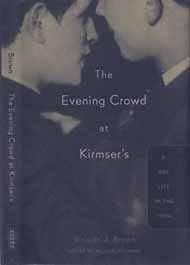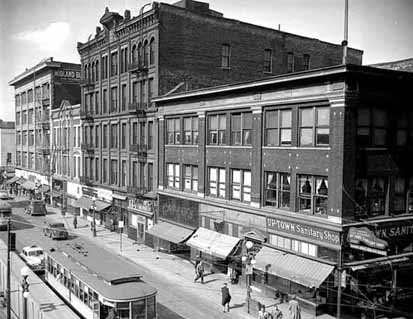Difference between revisions of "Kirmser's Bar"
(table) |
m (Protected "Kirmser's Bar" [edit=sysop:move=sysop]) |
||
| (One intermediate revision by one other user not shown) | |||
| Line 10: | Line 10: | ||
|- | |- | ||
| The queer population or St. Paul is indebted to Ricardo J. Brown, author of ''The Evening Crowd at Kirmser’s: A Gay Life in the 1940''s. Without Brown’s published memoirs, Kirmser’s bar would have disappeared from LGBT memory—the fate of many pre-Stonewall bars. The author was a working-class gay Minnesotan who wrote of “the only place we had,” in the vibrant (but declining) days of downtown St. Paul. | | The queer population or St. Paul is indebted to Ricardo J. Brown, author of ''The Evening Crowd at Kirmser’s: A Gay Life in the 1940''s. Without Brown’s published memoirs, Kirmser’s bar would have disappeared from LGBT memory—the fate of many pre-Stonewall bars. The author was a working-class gay Minnesotan who wrote of “the only place we had,” in the vibrant (but declining) days of downtown St. Paul. | ||
| + | |||
| + | |||
Latest revision as of 11:21, 1 May 2010
382 Wabasha Street, St. Paul
| The queer population or St. Paul is indebted to Ricardo J. Brown, author of The Evening Crowd at Kirmser’s: A Gay Life in the 1940s. Without Brown’s published memoirs, Kirmser’s bar would have disappeared from LGBT memory—the fate of many pre-Stonewall bars. The author was a working-class gay Minnesotan who wrote of “the only place we had,” in the vibrant (but declining) days of downtown St. Paul.
|
Cover of Ricardo J. Brown's book--The Evening Crowd at Kirmser's. Courtesy of the Jean-Nickolaus Tretter Collection. |
These patrons dressed inconspicuously; men wore loose-fitted slacks and cropped hair while women wore makeup and bright red lipstick. Outlandish dress and behavior risked losing one’s job, and jobs were precious after the Great Depression.
Owned by an old married couple with German backgrounds, Kirmser’s existed when most of St. Paul’s buildings dated from the 19th and early 20th centuries.
| East side of Wabasha Street between Fifth and Sixth in 1948. Kirmer's was likely located in the 3-story white structure to the left. Courtesy of the Minnesota Historical Society. |
One can nostalgically look back at this time, but many of these buildings were subdivided firetraps. For example, Kirmser’s had only one entrance and exit—the front door.
|
This page is still under construction. -SVC
Part of Minneapolis/St. Paul, MN: 100 Queer Places in Minnesota History, (1860-1969), (1969-2010)

